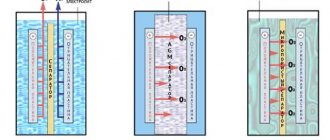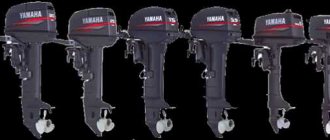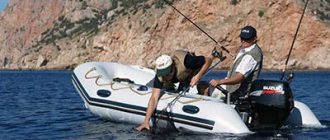When buying an electric motor for a boat, many people for some reason forget that it also requires a battery. Indeed, an electric motor will not float on its own; it requires a power source.
Some may happily remember that they have an unwanted car battery lying in the garage. However, we dare to disappoint them; a boat motor requires a special traction battery.
Starting battery
The starting battery, the one used in cars, is an auxiliary device. It is used to create a powerful single charge, starting a fuel engine, such as a car or motorcycle.
At the same time, its negative qualities are considered to be capriciousness in service. Since most batteries operate on a lead-acid operating principle, the charge should not fall below 20%, otherwise the battery capacity will drop. The so-called sulfatization of the electrodes occurs.
This happens when the lead involved in current transfer, in the absence of a charge, enters into a chemical reaction with the plate, thereby “drying out” and hardening.
Prolonged discharge can completely kill the battery. Also, a car battery is afraid of low temperatures. In winter, it needs to be periodically warmed up indoors. It is not suitable for long-term current maintenance.
Why can't you use a car battery?
Among fishing enthusiasts, there is still debate about whether or not a car battery can be used as a power source for a rubber boat motor. The fact is that a car battery, in its essence, is not a traction battery, but a starter battery . Its purpose is to provide a high level of current when starting an internal combustion engine. If you use a starter battery on a boat, the internal combustion engine must be equipped with a generator that recharges the battery while moving.
However, not all vehicles on water are equipped with internal combustion engines with a generator, and a small fishing boat is even more so. Not all internal combustion engines are equipped with generators that ensure the process of charging the battery while moving on water. Therefore, it is better to use compact lithium or gel batteries, which are the best option.
Main types of traction batteries
Speaking about the main types of traction batteries for fishing, we can distinguish 2 subtypes of lead-acid type: AGM and GEL, but first the lead-acid type.
This type of battery has lead plates located in a plastic or glass box, which are filled with an acidic electrolyte. In addition to the fact that the lead-acid type is widely used in starting batteries, it is also represented by traction batteries. The disadvantages are still the same: a high probability of failure.
However, this technology has been significantly improved by creating several subtypes:
- AGM (Absorbent Glass Mat - Absorbed glass fiber). Unlike the classic lead-acid battery, this technology is made not using liquid, but using compressed porous glass fiber. The use of acid here is minimal, which means that the possibility of sulfation of the electrodes is significantly reduced. Among other things, this type of battery is a maintenance-free type, that is, there is no need to fill it with electrolyte. The housing is made hermetically sealed and does not allow acid to escape. At the same time, the possibility of corrosion is prevented. However, there are also disadvantages, such as: sensitivity to overvoltage, heavy weight.
- GEL . Another type of battery for a boat electric motor, made on a lead-acid basis. A special gel-like liquid is poured into its body, which eliminates the possibility of leakage. Just like AGM, this type of battery is called maintenance-free, that is, it does not require any maintenance. And although this type of battery is expensive and has a slightly smaller number of charge-discharge cycles, it is recommended for outboard motors.
Rechargeable batteries with unusual electrolyte: GEL and AGM
Boat batteries may have different designations. In addition to indicating the manufacturer and model name, the manufacturing technology is also marked. As a rule, it is designated by the letters GEL or AGM. Gel boat batteries (GEL) are filled with a special electrolyte that has low fluidity. The thick consistency, similar in appearance to jelly, allows the battery to function fully even when installed at a large angle. This is very convenient when using a battery to provide electricity to a removable motor for a small boat.
The AGM marking indicates a slightly different electrolyte composition. Such batteries for outboard motors are filled with a material with a fiberglass base impregnated with liquid electrolyte. This technology, just like the gel version, does not allow the fluid substance to move freely inside the battery, which makes it possible to use it even on a water scooter.
Boat batteries made using AGM and GEL technology have a similar design. Many models presented on the Russian market, which are called gel batteries, are essentially AGM batteries. The fact is that both varieties belong to the lead-acid class of batteries, differing only in the composition of the electrolyte. Lead plates are placed in a sealed plastic case, the spaces between which are filled with a sulfuric acid solution (electrolyte). Modern AGM boat batteries have porous material between the plates, which, when absorbing sulfuric acid, becomes the electrolyte itself. And batteries marked GEL are filled with a thick compound.
As a rule, batteries for water vehicles have a maximum level of electricity output. This is due to the need to power the electric motor for a long time without recharging. Having less capacious batteries, boats and other vessels would not be designed for long walks away from the shore. After all, all vital water transport systems, such as navigation, control and others, work only when electricity is available. Therefore, boat batteries are much superior in performance to conventional batteries.
Advantages and disadvantages
Having considered the 2 main types of batteries for a boat, let’s go through their characteristics in more detail and identify their strengths and weaknesses.
So, the advantages of AGM technology
- Affordable price and large selection. Batteries of this type, as a rule, are widely represented in the entry-level price range, however, AGM batteries are also present among expensive models.
- Long service life. If you go fishing every weekend for a year, the battery should last for at least 7 years. The number of charge-discharge cycles is on average more than 800.
- The seal allows the battery to be charged without releasing hazardous substances.
- Possibility to place the battery on its side. Another useful feature is that it is sealed; it is not recommended to turn the item upside down.
- No need for battery maintenance.
Here are its disadvantages
- Inability to store the battery in a completely discharged state. Unlike GEL, the depth of discharge for glass wool type batteries should not exceed 20-30%.
- Reducing stress in cold weather. In cold weather, the battery will produce slightly less voltage. This may affect the efficiency of the motor.
Now let's look at the advantages of GEL
- Lower discharge level when idle. If a charged battery is not used in any way, after a month you can expect a discharge of no more than 5%, which is a good indicator.
- Deep Cycle ability.
- Resistance to extreme temperatures. From -30 to + 60.
- Improved vibration protection. Useful during strong waves.
- Even longer supply of cycle hours. With certain models of gel batteries you can charge the device more than 1000 times.
In general, all lead-acid batteries have common disadvantages.
- Heavy weight. Approximately about 30 kg, sophisticated models can weigh tens of kilograms more.
- Sensitivity to overdischarge. It should not be more than 25%.
- Not environmentally friendly. After use there is a need for special disposal.
What kind of battery is needed for a boat motor?
The selection of a battery for an electric boat motor is carried out according to 3 main parameters: manufacturing technology, output power and capacity. Based on the electrode manufacturing technology, rechargeable batteries are divided into traction, starter and universal. Batteries of all types are used on boats, but the advisability of their use depends on the type of engine and operating mode of the battery.
Let's take a closer look at each type of battery:
- Traction batteries are deep-discharge batteries, designed for stable cyclic operation in charge-discharge mode. They are designed for long-term use, release accumulated energy to the maximum, produce stable current and resist oxidation. Depending on the chemical composition, they can withstand 500–1000 operating cycles or more. It is traction batteries that are designed for intensive use in cyclic mode and frequent deep discharges, so they are excellent for powering boats and other electric motors.
- Starter batteries are batteries designed for short-term supply of high currents. They provide quick start of a diesel or gasoline engine, but are not suitable for use in constant energy output mode. Under prolonged loads, starter batteries quickly lose their charge and fail prematurely. On boats, cutters, catamarans and yachts, they are used only to temporarily power the internal combustion engine at the time of its startup.
- Universal (dual-use) – models that can operate in both modes. They produce a high starting current, but can also be used in charge-discharge mode as a constant power source.
Features of operation
In fact, the recommended AGM or GEL batteries do not require any special care. Both batteries are maintenance-free, which is their great merit.
However, this also means:
- Prohibition on opening. A large amount of oxygen will cause irreparable damage to the plates.
- The device should be charged no more than the size of its capacity allows. Use charge limiters.
- Be aware of lead toxicity. If the battery somehow gets holed, which is extremely rare, you should throw it away, but at designated recycling sites. This heavy metal is very dangerous.
- Don't forget about the low battery level. If it is below 20%, you should recharge the device; in the case of liquid electrolyte, this is critical.
- Do not use or store the battery at temperatures below -20°C or above +60°C.
Rating of models with prices
When choosing a traction battery, you should look at its capacity (Ah), durability (charge cycles), minimum voltage (V) and temperature conditions (°C).
The entire traction battery market can be divided into 3 categories:
- From 4 to 12 thousand rubles. Such batteries are quite good, they have an average capacity (from 70 to 100 A/h), resistance to vibration, and among them there are deep discharge models. Regarding technology and type, there are few gel batteries in this price range. These are mainly AGM models. And here you should be wary of the so-called calcium batteries. This is the same lead-acid battery, only with the addition of calcium as an impurity to the lead. There is an opinion that after a deep discharge, this type of battery cannot be restored. Therefore, if you plan to completely discharge your device, it is better to look into the next price category
- From 12 to 20 thousand rubles. Gel models are already included here. These are the ones we recommend for boat electric motors. They are durable, stable at the lowest temperatures, and produce good voltage, which is important for motor power. Let us separately note their capacity – from 100 to 150 A/h. But, if you are planning a long fishing trip and want to take a model with improved capacity, models starting from 20 thousand rubles will suit you.
- From 20 to 40 thousand rubles. These are the top batteries for electric motors on the Russian market. They are distinguished by a large starting charge, almost comparable to starters, and a huge capacity volume (from 150 to 245 A/h). And some of them, in addition to everything, contain reserve capacity.
How to choose the right battery
Traction batteries for a boat motor should be selected based on the concept of the boat’s power reserve. The task of the traction battery is to provide this reserve. If the engine operates at full power, this figure should be two hours, and if the engine operates not exceeding the original power, the optimal power reserve is about four hours.
When choosing a battery for a boat, it is important to pay attention to how much it weighs. The maximum permissible weight is no more than 20 kilograms, so that there are no serious problems with the battery on a small boat. The self-discharge of such batteries is desirable, the less the better, in order to avoid a large loss of nominal capacity. Since modern batteries are most often maintenance-free (for example, it has long been no longer possible to top up the electrolyte when it evaporates), caring for them should only consist of periodically recharging them.
Charger
Well, now that we have familiarized ourselves with the main characteristics of batteries, examined models of different categories, let's talk about the charger.
Due to the fact that AGM and GEL batteries do not like overload during charging, there is a special charger for each device.
It helps to quickly restore charge and most importantly takes into account the required battery capacity (for example, for batteries from 15 to 130 A/h). The charger contains an indicator and compensates for the falling voltage.
A charger today costs from 5 thousand rubles, weighs about a kilogram and has medium-sized dimensions. If it is not there, you can use your car, but you need to remember that the highest acceptable voltage for a GEL battery is 13.9 V, and for an AGM 14.4 V.
However, these figures strongly depend on the ambient temperature; the lower it is, the higher the voltage (within a few tenths) can be applied.









